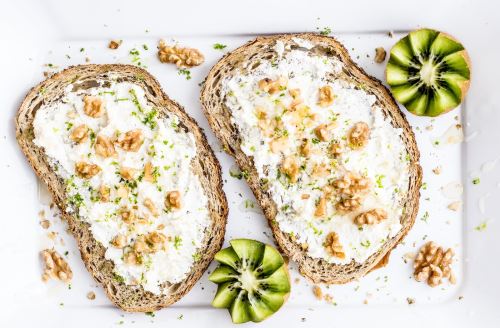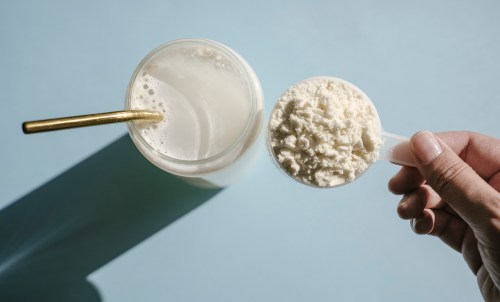Our editors independently select these products. Making a purchase through our links may earn Well+Good a commission
Ah, bread: Can’t live with it, can’t live without it. In a world where low-carb diets like keto are commanding more of the spotlight, our relationship with starchy goodness has become pretty complicated. But according to one dietician, it doesn’t have to be.
“Every bread has value,” says Jessica Perez, RD. “Bread has become the enemy, whereas 10 years ago, fat was.”
So…is bread healthy? Yes, says Perez—but in moderation. As long as you don’t suffer from Celiac disease or a gluten intolerance, she says there’s plenty of room in anyone’s diet for a slice or two. Great news for all of us who are on Oprah-levels of loving bread.
Of course, there are certain breads that offer more nutrition per slice than others (major side-eye at you, white bread). When it comes to shopping for a healthy bread, Perez says there are a few varieties in particular that should be on your radar—and in your cart:
1. Whole grain bread
Perez says to always opt for whole grain bread. That’s because whole grain bread contains all three parts of the grain intact: the inner endosperm, which contains carbohydrates and a small amount of nutrients, the outer germ, which contains healthy fats, and the outer bran, which is loaded with fiber, antioxidants and B vitamins. White and wheat breads, meanwhile, use flours that have only the inner endosperm of the grain—which cuts down on the amount of nutrients you get from your loaf.
Preserving all parts of the grain matters for your health. After all, studies show its consumption is linked to reduced incidences of cancer, heart disease and a host of other benefits. Perez also notes whole wheat bread’s unrefined carbohydrate content provides a slow-releasing form of energy, a moderate amount of protein for satiety, B vitamins, minerals and phytonutrients.
And no, whole grain is not quite the same thing as whole wheat bread. “Whole wheat bread is just the whole grain version of wheat specifically,” Perez says. “I wouldn’t say one is healthier than the other, it’s just that it’s wheat as opposed to another grain.” Think of it this way, says Perez: Just how all apples are fruit but not all fruit are apples, so too are all whole wheat breads whole grain, but not all whole grain breads are whole wheat.
Perez says to look for “100 percent whole grain” on the packaging when looking for whole grain bread. This will ensure that every grain used is in its whole form, giving you the maximum benefits per slice. Language like “multigrain” and “made with whole grains,” she says, mean that a variety of grains (refined and whole) have been used.
2. Sprouted bread
Sprouted grains are basically whole grains on steroids. Let’s go back to the idea of the grain—the inner endosperm and outer germ and bran. In the right conditions and temperature, Perez says that germ will sprout, or germinate.
Health experts are divided over whether sprouted bread is significantly “better” for you than your standard whole grain bread. But it has a lot in its favor: Research shows sprouted breads can increase the bioavailability of important minerals like folate in the body. And sprouted breads contain higher amounts of lysine, an essential amino acid that helps with calcium absorption, hormone production, and wound recovery. “Not a lot of grains are high in lysine so it’s a benefit,” says Perez. And some research also shows that sprouted grains have more fiber than non-sprouted varieties.
One caveat: If your doctor has put you on a low-insoluble fiber diet (which is usually prescribed to people with GI issues), it’s best to avoid sprouted breads specifically since their fiber content can exacerbate symptoms, says Perez. Once your symptoms are resolved, she says it’s safe to re-introduce fiber—and thus sprouted bread—back into your diet slowly with your doctor’s permission.
3. Sourdough bread
Sourdough bread is as “rustic” as they come, but it’s only gained traction in recent years (unless you live in San Francisco, in which case it’s your literal bread and butter). In traditional bread baking, yeast activates the gluten and makes it rise. Sourdough, however, requires a starter that consists of yeast and bacteria growing inside a paste made from flour and water, Perez says. The bacteria then create lactic acid and ferment the dough, giving it that sour-ish aftertaste.
“People go for it because it’s lower on the glycemic index so it doesn’t raise your blood sugar as much as refined bread,” she says (although that thinking has been challenged thanks to a small 2017 study that found that some people did see their blood sugar spike after eating sourdough while some people didn’t). “It’s also good for gut health since it’s fermented,” Perez adds. And you can buy whole grain versions of it, too for the best of both worlds.
The “healthy” bread you should skip (unless you need it)
People hear the word “gluten-free” and automatically assume it’s healthier than anything with gluten in it. But when it comes to GF bread, Perez doesn’t recommend eating it unless you need it (aka if you suffer from gluten intolerance or Celiac disease). “I never recommend it. It’s not for everyone under the sun,” Perez says. She says that gluten-free bread tends to contain fewer B vitamins and fiber than its gluten-containing counterparts. And she says taste-wise it can often be lacking: Gluten gives bread its elasticity and structure, making gluten-free breads often hard and dense err often on the side of “hard and dense.”
Instead of opting for breads made with gluten-free flour (which are often super-processed and full of additives), she says to look for loaves made with naturally gluten-free whole grains like sorghum or buckwheat to ensure your bread also comes with a slew of vitamins and minerals. Just make sure that the loaf has a certified gluten-free label on if it you have an allergy to ensure nothing was cross-contaminated during processing.
Are there any downsides to eating bread?
Of course, this doesn’t mean that you can just go wild and eat a whole loaf of bread a day (as tempting as that thought is). Like anything else, you need to watch your portion sizes. Perez recommends eating no more than two servings of bread per meal (aka no more than two slices at a time) with at least two grams of fiber per slice. “It’s best just to help regulate blood sugar and not overeat,” she says—and going overboard on any bread, even the low-glycemic kind, can mess with your blood sugar. “You can get carbs elsewhere like vegetables and fruit,” she says, adding that it’s important to leave room for other foods without carb-loading.
Love carbs? Here’s why a RD says she’ll never, ever break up with them. And if you needed any more reason to say yes to carbs, you should probably learn about the Mediterranean diet.
Sign Up for Our Daily Newsletter
Get all the latest in wellness, trends, food, fitness, beauty, and more delivered right to your inbox.
Got it, you've been added to our email list.











